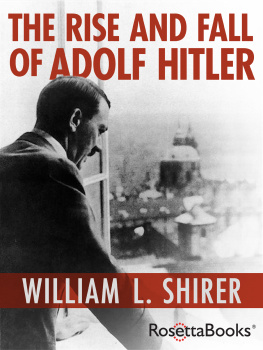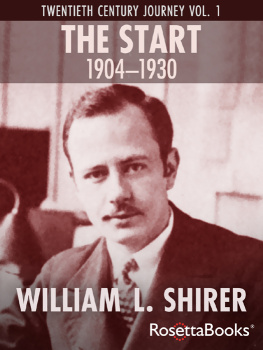Shirer - This is Berlin
Here you can read online Shirer - This is Berlin full text of the book (entire story) in english for free. Download pdf and epub, get meaning, cover and reviews about this ebook. City: Berlin, year: 2013;2012, publisher: Random House;Cornerstone Digital, genre: Detective and thriller. Description of the work, (preface) as well as reviews are available. Best literature library LitArk.com created for fans of good reading and offers a wide selection of genres:
Romance novel
Science fiction
Adventure
Detective
Science
History
Home and family
Prose
Art
Politics
Computer
Non-fiction
Religion
Business
Children
Humor
Choose a favorite category and find really read worthwhile books. Enjoy immersion in the world of imagination, feel the emotions of the characters or learn something new for yourself, make an fascinating discovery.
- Book:This is Berlin
- Author:
- Publisher:Random House;Cornerstone Digital
- Genre:
- Year:2013;2012
- City:Berlin
- Rating:5 / 5
- Favourites:Add to favourites
- Your mark:
- 100
- 1
- 2
- 3
- 4
- 5
This is Berlin: summary, description and annotation
We offer to read an annotation, description, summary or preface (depends on what the author of the book "This is Berlin" wrote himself). If you haven't found the necessary information about the book — write in the comments, we will try to find it.
Shirer: author's other books
Who wrote This is Berlin? Find out the surname, the name of the author of the book and a list of all author's works by series.
This is Berlin — read online for free the complete book (whole text) full work
Below is the text of the book, divided by pages. System saving the place of the last page read, allows you to conveniently read the book "This is Berlin" online for free, without having to search again every time where you left off. Put a bookmark, and you can go to the page where you finished reading at any time.
Font size:
Interval:
Bookmark:
Contents
Before Britain and Germany went to war in 1939, Ed Murrow of CBS sent his star reporter William Shirer to report from Berlin on what was really happening in Hitlers Germany. And there Shirer stayed until December 1940, reporting on the war from within the Reich, battling against the censors and revealing to American and British audiences how Hitler, the SS, and his armed forces were conducting the war, and what it meant to live in a Nazi state. All through the campaigns leading to the fall of France, Dunkirk and the Battle of Britain, Shirer provided a unique and dramatic by-line on history as it happened, and now his writings have been gathered together for the first time into a vivid, compelling and urgent narrative, one of the great first-hand documents of the Second World War.
William L. Shirer ranks as one of the greatest of all American foreign correspondents. He lived and worked in Paris, Berlin, Vienna and Rome, but it was above all as correspondent in Germany for the Chicago Tribune and later for the Columbia Broadcasting System in the late thirties that his reputation was established. He subsequently wrote The Rise and Fall of the Third Reich, which is hailed as a classic, and after the war he was awarded the Legion dHonneur. In the post-war years he wrote in a variety of fields, and in his seventies he learned Russian, publishing a biography of Tolstoy at the age of 89. He died in 1994.
Berlin Diary
End of a Berlin Diary
Midcentury Journey
The Challenge of Scandinavia
The Collapse of the Third Republic
The Rise and Fall of the Third Reich
Love and Hatred: The Stormy
The Sinking of the Bismarck
Gandhi: A Memoir
Marriage of Leo and Sonya Tolstoy
20th Century Journey (Autobiography, Vol. 1)
The Nightmare Years (Autobiograph, Vol. 2)
A Natives Return (Autobiography, Vol. 3)
The Traitor
Stranger Come Home
The Consuls Wife

Shirers press pass issued by the Nazi Party (W. L. Shirer collection)
Your correspondent with a muffin (W. L. Shirer collection)
Shirer with his daughter Inga (W. L. Shirer collection)
Shirer with his wife Theresa (two photos, both W. L. Shirer collection)
Shirer preparing a Berlin broadcast (W. L. Shirer collection)
Murrow and Shirer arrive in Paris (W. L. Shirer collection)
Shirer working at Compigne (W. L. Shirer collection)
Victory or Bolshevism (from the illustrated Rise and Fall of the Third Reich)
The Volksempfnger (from the illustrated Rise and Fall of the Third Reich)
Hitler Youth poster (from the illustrated Rise and Fall of the Third Reich)
salute (Imperial War Museum)
Hitler and Mussolini in Rome (two photos, France Presse and (bottom) W. L. Shirer collection)
Dr. Josef Goebbels (Bundesarchiv)
Stormtrooper outside Jewish shop (Bundesarchiv)
Jews are forced to scrub pavements in Vienna (Imperial War Museum)
Chamberlain claims peace in our time (Imperial War Museum)
and children (National Archives)
Citizens of Prague watch German motorized troops (CTK)
German troops in Prague (TPS/3 Lions)
Molotov signs the GermanSoviet non-aggression pact (National Archives)
Potsdam children with gas-masks (Care Photo)
Hitler speaks to Reichstag about the counter-attack on Poland (Bundesarchiv)
)
Sunken British ships at Dunkirk (Bundesarchiv)
German anti-tank gun outside La Gare de lEst (Bundesarchiv)
German troops parade past the Arc de Triomphe (Bundesarchiv)
Shirer with his censors (W. L. Shirer collection)
William L. Shirer was, when he died in 1993, two months short of his ninetieth birthday, one of the most famous journalists in the world. His best known achievement was his monumental book, The Rise and Fall of the Third Reich (1959), one of the most successful works of contemporary history published in this century, though his fame had already been made by his Berlin Diary. Both were based on the years he spent as a Chicago Tribune and later Columbia Broadcasting System (CBS) reporter in the German capital before Hitlers seizure of power and during the first seven years of the Nazi era.
Shirer, the individual, remarkable figure though he was, ought properly be seen, however, in the context of the generation to which he belonged, that generation of self-confident, fact-seeking, radical Americans who left the young United States to bring their fellow-countrymen the truth, as they perceived it, of events in the Old World and in the rest of the globe which belonged to or depended upon it. Theodore White was such an American, so was Virginia Cowles, so was Ed Murrow, whose relationship with Shirer was to be a decisive influence on his life. They established, long before Tom Wolfe coined the phrase, the New Journalism. John Reed had been a precursor. Reed, author of Ten Days that Shook the World, was, however, too partisan to be counted among the true band of American pioneers, while Hemingway was too solipsistic. He confused the reportage of great events with personal adventure and resolved that dilemma only in novel form. White, Cowles, Murrow and Shirer showed themselves to be true New Journalists in their impartiality, their eschewal of self-dramatization, their whole-hearted resistance to censorship, their suspicion of news management, their determination to see for themselves and their passion for the truth.
It is significant that Shirer, like Hemingway, was a Chicagoan, and of almost the same generation. The capital of the Middle West was, in the years before the Great War in which both men grew up, a fountainhead of American energy and independence, detached from the Europeanism of the East Coast and proud to represent the free-thinking, undeferential spirit of the great republics heartland. That heartland thought the Old World and much of what it stood for the persistence of a hierarchy of classes, the ethos of imperialism, the code of conformity, the repression of individual enterprise a society ripe for exposure.
Spain, during the Spanish Civil War, was the theater in which the New Journalists first practiced their mission though Theodore White was already at work in corrupt old China, and Virginia Cowles in the shaky Versailles states of Central and Southern Europe. It was the rise of Nazism, however, which gave the American missionaries their great chance. Shirer was foremost among them. He had already, before Hitlers appointment as Reichschancellor in 1933, cut his European teeth, working for the Chicago Tribune and other newspapers in several European countries and acquiring fluency in French and German.
Germany was to be the key to his success as a journalist. In 1937, once again out of a job, a familiar interruption in the careers of expatriate American journalists in the Depression years, he met Ed Murrow, an established CBS newsman, in Berlin. Murrow, later to become the authentic voice of America from blitzed London, got him hired on the spot. When Murrow returned to Britain, Shirer became the principal CBS European correspondent, based first in Vienna, then in Berlin. In 1938 he began the series of broadcasts, most of them introduced by a crisp This is Berlin, which was to make him famous across America.
Next pageFont size:
Interval:
Bookmark:
Similar books «This is Berlin»
Look at similar books to This is Berlin. We have selected literature similar in name and meaning in the hope of providing readers with more options to find new, interesting, not yet read works.
Discussion, reviews of the book This is Berlin and just readers' own opinions. Leave your comments, write what you think about the work, its meaning or the main characters. Specify what exactly you liked and what you didn't like, and why you think so.










